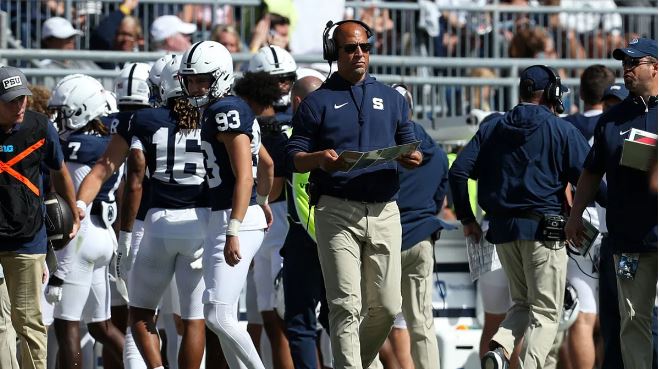
Penn State football’s biggest concerns after tight win over Bowling Green
Penn State did not look good in their narrow win over Bowling Green.

The Penn State Nittany Lions’ narrow escape against Bowling Green has raised eyebrows and sparked concern among fans and analysts alike. Despite emerging victorious with a 34-27 win, the performance was far from reassuring, especially when juxtaposed with their dominant display in the season opener against West Virginia. The disparity between the two games has highlighted some significant issues that could have far-reaching implications for Penn State’s season ambitions.
In week one, Penn State appeared to be a formidable force. The Nittany Lions, under the guidance of head coach James Franklin, confidently defeated West Virginia 34-12 in a game that showcased their potential and set high expectations for the season. This win was particularly impressive given the challenging road environment, suggesting that Penn State was well-prepared and focused on their goals.
However, the optimism surrounding Penn State’s season took a hit in week two. Facing Bowling Green at home, the Nittany Lions exhibited a lackluster performance that contrasted sharply with their previous outing. Early in the game, Bowling Green took the lead and even managed to extend their advantage to two scores. At one point, the scoreboard read 17-7 in favor of the Falcons, casting a shadow of doubt over Penn State’s capabilities. Despite a spirited rally in the second quarter, the Nittany Lions trailed 24-20 at halftime, which only exacerbated the sense of unease.
The second half saw some improvement from Penn State, particularly on defense, which tightened up and prevented further scoring by Bowling Green. Nonetheless, the offense struggled to find its rhythm, adding only 14 points after halftime. This lackluster performance was sufficient to secure a win, but it was clear that Penn State’s effort was far from what would be required to compete at the highest levels, especially with Big Ten play looming.
James Franklin has been a steady presence as head coach, leading the Nittany Lions through various highs and lows over the past eight years. Despite his efforts, Penn State has often fallen short of their ultimate goal: a College Football Playoff appearance. The 2016 season was a notable exception, as Penn State won the Big Ten Championship, yet they still missed out on the playoff due to a combination of factors, including a loss to Michigan and a lack of a strong overall resume.
The landscape has changed with the expansion of the College Football Playoff, allowing for more flexibility in playoff berths. Penn State now has the opportunity to make the playoffs even if they don’t win the Big Ten, but this hinges on their ability to perform consistently well throughout the season. The close call against Bowling Green raises questions about whether the Nittany Lions are prepared to meet these expectations.
One of the most pressing concerns is the performance of quarterback Drew Allar. As the starting quarterback, Allar is pivotal to Penn State’s success. His performance against Bowling Green was underwhelming. With a stat line of 13 completions on 20 attempts for 204 yards, two touchdowns, and one interception, Allar’s game was marred by inconsistency. The interception, in particular, was a critical error, coming deep in Bowling Green territory and stalling a potential scoring drive. For Penn State to realize their playoff aspirations, Allar must improve and demonstrate the kind of playmaking ability expected of a top-tier quarterback.
In addition to the offensive struggles, the defense’s performance is equally concerning. Although the defense improved in the second half, the first-half showing was problematic. Bowling Green’s offensive efficiency was alarming, with the Falcons on pace to score 48 points by halftime. While Penn State’s defense is generally considered strong, this game highlighted vulnerabilities that could be exploited by more formidable opponents in the Big Ten. The disparity between the first and second-half performances underscores a need for greater consistency and adjustments, especially when facing high-caliber teams.
Despite these issues, it’s important to contextualize the performance within the broader scope of the season. While Penn State’s play against Bowling Green was concerning, it’s not uncommon for teams to have off days, particularly in early-season games. A notable parallel can be drawn with Michigan’s performance last year. The Wolverines also had a shaky game against Bowling Green, including three interceptions by quarterback JJ McCarthy. Despite this, Michigan went on to win the national championship, demonstrating that a single underwhelming performance does not necessarily define a season’s trajectory.
For Penn State, the focus now shifts to addressing these concerns and preparing for the upcoming games. The early bye week offers a crucial opportunity for the team to regroup and make necessary adjustments. Following the bye week, Penn State will face Kent State, providing another chance to fine-tune their game before the onset of Big Ten play. The game against Illinois, which will kick off their conference schedule, will be a significant test of their ability to compete at the highest level.
However, while the narrow win over Bowling Green has raised valid concerns about Penn State’s readiness for the challenges ahead, it is not an insurmountable obstacle. The Nittany Lions have the talent and potential to address these issues and achieve their goals. The key will be how effectively they can use the insights from this game to improve their performance in subsequent matchups. For now, Penn State must remain focused, address their weaknesses, and prepare for a season that still holds great promise.

Leave a Reply